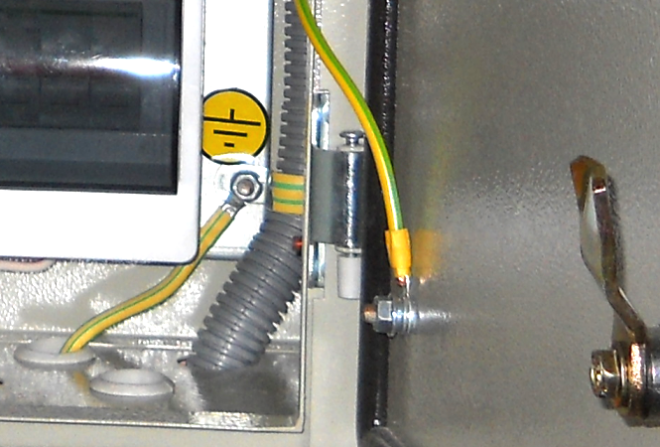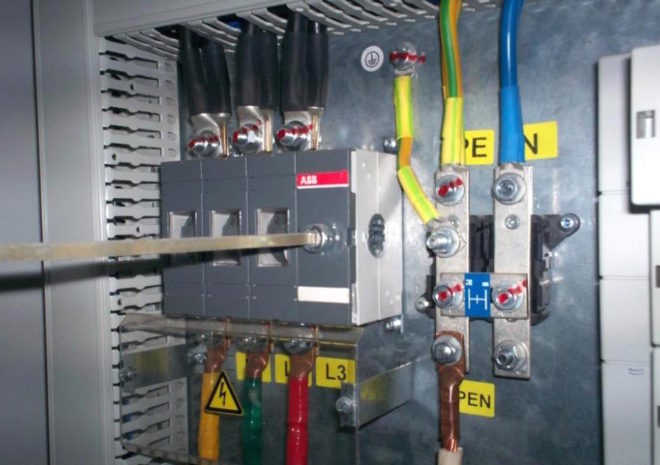PE conductor - what is it and what is it for

The TN-C grounding system, despite the fact that it is still used in most apartment buildings, is outdated and is being actively replaced by TN-S or TN-C-S, which are more advanced in terms of protection. As a result, circuit diagrams use N as a working zero, and the PE conductor is a protective zero that appears in the circuit after the PEN wire is separated, or taken directly from the ground loop.
Content
Basic requirements for PEN conductor separation
Everything you need to know for the competent performance of such work is spelled out in the provisions of the PUE. In particular, the need to make such a connection is stated in clause 7.1.13

How the connection should look on the diagram is described in clause 1.7.135 - when in some place of the REN the conductor is divided into neutral and ground wires, their subsequent unification is not allowed.

After splitting, the tires are considered different and must be marked accordingly - zero in blue and PE in yellow-green.
The jumper between the grounding bus and zero is made of a material with a cross-section no less than the busbars themselves from which the PE and N wires go further. In this case, the PE protective conductor bus can contact the transformer case, and the n bus is separately installed on insulators. The PE bus must be grounded - ideally there must be a separate circuit for it (PUE - 1.7.61).

When using RCD devices, the zero used to connect electrical equipment should not in any way contact the zero that comes to the input machine and the counter. All these devices are connected according to this principle.
The place of separation of the PEN conductor into PE and N wire, for a number of reasons, is carried out in the ASU, which stands at the entrance to an apartment or private house.
The PEN wire, which will be divided into a working zero and ground, must have a cross section of at least 10 mm² if it is copper, and 16 squares if it is aluminum. Otherwise, separation is prohibited.
Why it is impossible to separate the PEN conductor in the floor board

This option cannot be used for a number of reasons:
- If we take into account exclusively the provisions of the PUE, then they say that the separation of the wires should take place on the input machine of an apartment or private separate house.
- Even if the apartment panel is considered a water machine (which is quite problematic to do), such a connection will be incorrect according to another requirement, namely, the PE conductor must be re-grounded, which is impossible to achieve in the floor panel.
- Even if you contrive and bring grounding to the floor panel, then there is another obstacle that threatens with large fines. The fact is that the electrical circuit during the construction of a house is approved in several instances and its unauthorized change is a gross violation of all existing rules - in fact, this is a change in the project by which the house was connected to the network. Such matters should be handled exclusively by the organization serving this house or area.
Of course, if such an organization will plan any work on dividing the Pen conductor, then there is no point in fiddling with each floor panel separately. The best option would be to divide it on an introductory machine, which will be done.

An additional argument in favor of dividing the Pen conductor on one automaton of a residential building is the requirement of the PUE (clause 7.1.87) to mount a potential equalization system in this place.

It is forbidden to do it anywhere else, which means that the separation of the PEN conductor in the floor board will in any case be done without observing all the necessary rules and precautions.
As a result, the only correct method to make grounding in the house is a collective appeal to the organization serving the house or area.
Why share a PEN conductor if a jumper is placed between PE and N buses - the "physics" of the process
A direct answer to this question in the PUE and GOSTs is not given - there are only recommendations “how to do it”, and “why” is not considered, most likely on the basis of the assumption that it should be clear anyway. Therefore, all subsequent explanations should be taken as the opinion of the author, supported by the principles of connecting electrical wiring and the requirements of the PUE.
The main points here are as follows:
- In any diagram, which illustrates the separation of the PEN conductor into PE and N, the ground is always set first and a jumper goes from it to the working zero. This is the main requirement from which one must build on when dividing the PEN conductor - on the contrary, it is never done and under no circumstances.
- Even a separate grounding is most effective when connected through an RCD. Otherwise, even if the voltage with the housing of the electrical appliance goes into the ground, there is still a risk of electric shock to a person, although it is much less.
- Any wire has a certain electrical resistance, respectively, the longer the wire, the higher its resistance to electric current.
To understand the very "physics of the process" it is necessary to consider how different connection schemes behave in the event of an emergency situation.
If there is no jumper and an RCD, zero and ground are not connected
The phase falls on the device body from it goes to the grounding bus from it goes into the ground along which it goes to the transformer substation.
If we take the average value of the resistance of the grounding device of 20 ohms, the short-circuit current will not be large enough to turn off the input circuit breaker. Accordingly, the electrical circuit will work until the damaged area burns out (in any case, there will be an elevated temperature in this place and the wire will deteriorate sooner or later), or the damage will not develop into a full-fledged short circuit between phase and zero.
In the best case, here a person can be sensibly "tickled" by electric current or the device can deteriorate. At worst, the appliance can ignite and start a fire.
If there is a jumper between zero and ground, there is no RCD
In this case, the circuit works in much the same way as if you just bring a PEN conductor into the house, with the only difference that the person will be more protected thanks to grounding. This will happen precisely because of the length of the wire - since in any case the ASU is located at some distance from the apartment or house, the resistance of the wire must be taken into account.
When the phase is closed to the device case, the leakage current will go to the grounding bus, where it will have only two outputs: part of it will go into the ground, and the other will return through the zero wire, triggering the disconnection of the input apartment machine.
That is, in this case, the jumper is needed in order for the protective circuit breaker to work.
If there are jumpers between PE and N, an RCD is installed
Since the neutral and grounding wires have a certain resistance to electric current, it is clear that in this case the RCD will operate normally. If a short circuit appears on the device case, the leakage current, first of all, goes through the wire to the RCD itself, and then it goes to the ASU of a residential building.Here, again, it partially goes into the ground and partially returns back through the jumper provoking the switching off of the input machine, but most likely it will not come to that, since the RCD will work earlier.
It is clear that in this case, the jumper does not play a special role and is more an unnecessary reinsurance for that almost incredible case if the RCD protective circuit breaker does not work.
If there is no jumper between PE and N, an RCD is installed
Such a circuit will work in the same way as if a jumper between ground and working zero was present. The only exception to it is the lack of insurance in case the RCD suddenly fails. Then the circuit will work according to the first option - the input automaton may not work until the short circuit to the device case turns into a short circuit between phase and zero.
In fact, such a variant of events is practically impossible, because in fact such a connection is already a TN-S or even TT grounding scheme, in which two-factor protection is provided - without it, such a connection will not accept energy supervision.
Features of the separation of the PEN conductor at the entrance to a private house
To prevent the theft of electricity, the representative of the energy supervisor may require that the PEN wire be connected directly to the meter and after that it be divided into the PE conductor line and the working N. meter and seal the input machine. In this case, the connection will be more reliable, the requirements of the PUE are fulfilled, and the inspectors receive a line protected from unauthorized access.
For more information about PE and PEN conductors in a private house, see this video:
As a result, when performing the separation of the PEN conductor, it is enough to know and apply the requirements of the PUE, which give comprehensive recommendations on this issue, regardless of the place and methods of connection.



